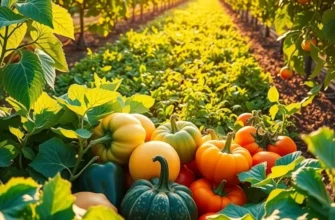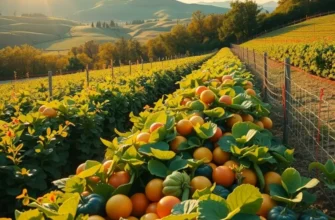Choosing locally sourced food significantly reduces environmental impact by minimizing food miles and conserving natural resources. By being mindful of where our meals originate, we can support local economies, reduce emissions from transportation, and enjoy fresher produce. Making eco-friendly food choices does not just benefit the planet; it also enhances our health and well-being. Here’s how you can easily incorporate these sustainable practices into your daily life.
Embrace the Power of Local Markets

Shopping at farmers’ markets and local farms can profoundly transform how we connect with food. By buying directly from producers, we reduce food miles, ensuring fresher produce while supporting our local economies. Let’s delve into the remarkable benefits and offer some practical tips for embracing this sustainable lifestyle.
One of the key advantages of local markets is having access to produce at its peak freshness. Food picked at its prime truly offers superior taste and nutrients compared to items that often travel long distances to reach grocery shelves. Shorter transportation not only preserves quality but also significantly reduces the carbon footprint associated with moving goods over long distances.
Beyond individual benefits, shopping locally nurtures communal bonds. Engaging with the people who grow and harvest our food fosters relationships that reinforce a supportive local economy. Money spent at local markets tends to recirculate within the community, encouraging economic resilience and boosting local employment.
Finding local markets is simpler than it might seem. Websites dedicated to promoting farmers’ markets are invaluable resources, as are local bulletin boards and social media groups. Additionally, visiting nearby farms often unveils hidden gems where farmers sell fresh goods directly. The journey to discover these locations can be as enjoyable as the markets themselves, offering scenic routes and insights into local agriculture.
Seasonal eating is another powerful aspect of shopping locally. Consuming foods in their natural season enhances flavor and creativity in the kitchen. Autumn’s harvest might inspire warming dishes filled with squash and root vegetables, while summer can abound with vibrant salads featuring juicy tomatoes and cucumbers. For practical ideas on incorporating seasonal produce into your meals, explore minimal prep dinner ideas here.
While some might perceive it as a limitation, seasonal eating encourages adaptation and culinary exploration. It respects nature’s cycles, teaching us to appreciate and utilize produce at its best. Embracing this journey cultivates a deeper understanding of our food sources and their impact on our environment.
Integrating local market shopping into daily routines doesn’t require drastic changes. Start small: swap one grocery store visit with a trip to your local farmers’ market. Experience the vibrant atmosphere, engage with producers, and delight in the variety of produce unfamiliar to supermarket settings. Small, consistent steps can greatly enhance sustainable living habits.
By supporting local markets, we actively participate in a movement that cherishes the land, the community, and the culture surrounding the food we consume. This practice fosters economic vitality and environmental stewardship, contributing to a balanced and meaningful lifestyle. Together, let’s embrace the power of local markets, not only for their bounty but for the sustainable future they help create.
Culinary Creativity with Seasonal Ingredients

Embracing the changing seasons in your cooking routine not only adds variety to your meals but also underscores the importance of supporting local agriculture. Leveraging seasonal produce can invigorate your menu, offering a fresher, tastier, and often more nutritious dining experience. When planning your meals around seasonal ingredients, begin by familiarizing yourself with what produce is abundant during different times of the year in your area. This approach not only supports local farmers but also significantly reduces food miles, as these ingredients haven’t been transported over long distances.
Cooking with seasonal ingredients requires a bit of flexibility and culinary creativity. For instance, summer might bring an abundance of tomatoes, corn, and zucchini, while winter might be rich with root vegetables such as carrots, parsnips, and turnips. By adopting a flexible meal planning approach that revolves around these ingredients, you can create a diverse array of dishes.
Simple Recipes to Highlight Seasonal Produce
- Roasted Winter Vegetable Medley: Combine sweet potatoes, carrots, and Brussels sprouts in a large bowl. Toss with olive oil, salt, and pepper, then roast in the oven until tender and slightly caramelized. This dish makes a hearty side or can be served over grains for a complete meal.
- Summer Corn Salad: Mix fresh corn kernels, diced tomatoes, avocado, and red onion. Dress lightly with lime juice, olive oil, and a pinch of salt. This vibrant salad pairs well with grilled proteins or can be enjoyed as a standalone light lunch.
- Autumn Apple and Squash Soup: Sauté onions, garlic, and cubed squash until slightly softened. Add diced apples, vegetable broth, and spices of your choice. Simmer until everything is tender, then blend until smooth for a comforting soup.
By consistently prioritizing seasonal ingredients, you can reduce your environmental impact while boosting the flavor diversity in your diet. If you’re new to seasonal cooking, consider beginning with a simple plan: identify a few seasonal ingredients each week and build your meals around them. Not only does this encourage healthier eating habits, but it also supports sustainable agriculture.
To enhance your skills further, you might find value in learning how to store these ingredients properly to reduce waste. Efficient kitchen storage strategies can maximize the lifespan and freshness of your ingredients. For more tips on eco-friendly kitchen practices, this guide on eco-smart kitchen storage offers practical advice.
Through seasonal cooking, you not only cultivate a deeper connection with your local foodscape but also contribute to a more sustainable future. Embrace the challenge of crafting meals that align with the natural seasonal rhythms, and you will find a renewed appreciation for each dish you create.
Final words
Reducing food miles is a vital step towards achieving sustainable living. By incorporating local produce into our diets and embracing seasonal ingredients, we can collectively contribute to minimizing our ecological footprint. Not only does this practice support nearby farmers and businesses, but it also enhances our meals’ freshness and taste. Let’s commit to making more conscious and eco-friendly food choices, paving the way for a healthier planet and a thriving local economy.








